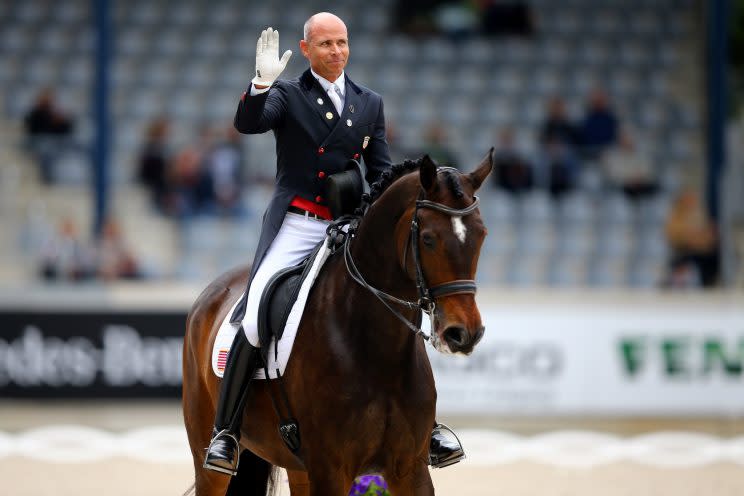The unlikely story of a 51-year-old Olympian...and his horse

RIO DE JANEIRO – Laura Graves describes her teammate as “smart and funny.” Steffen Peters calls his “one of those great personalities … with a great sense of humor.”
Kasey Perry-Glass says hers is “quiet … and very sensitive.” And Allison Brock says her teammate is “very sweet and evolved into a very solid competition partner.”
They’re not talking about other people, however. Graves, Peters, Perry-Glass and Brock are the four members of the U.S. dressage team, and they’re discussing their horses.
Dressage isn’t, and probably never will be, a sport that appeals to the masses. Not too many city kids learn to ride a horse, particularly ones that cost, in many cases, in excess of $1 million.
But these aren’t snooty rich folks at the dais talking about their country club sport. They’re real people, real athletes with a sense of humor who love their horses as if they were family and who share a dream of winning a medal.
Their horses arrived in Rio by plane after a 12-hour flight from Belgium where they made the trip in specially designed stalls. The cargo area is temperature-controlled, and the pilots give wide latitude to the riders regarding how cool or warm they want the cargo hold to be kept.
“Sometimes, [the temperature] depends on the cargo you’re flying with,” Graves said. “A great load to be on with is flowers. It’s usually a great temperature. But the pilots are usually very accommodating.”

The four athletes were patient and accommodating to the handful of media who showed up Tuesday, some of whom knew next-to-nothing about dressage when they entered the news conference.
Peters is 51 and preparing for his fourth Olympics. He first competed in 1996 in Atlanta, where he won a bronze medal in the team dressage competition.
His teammates, all first-time Olympians, kiddingly refer to him as “Uncle Steffen.”
Peters grins wryly at the mention of his age, but beams as Brock comes to his defense and notes how hard he works in the gym.
“To be totally honest with you, the best riders in our sport are older,” Brock said. “I think we all look at Steffen and hope we’re doing what he’s doing at his age, compared to the other athletes in other sports.”
Japan’s Hiroshi Hoketsu was 71 when he competed in London in 2012 and only withdrew from consideration for the 2016 Games when his horse became ill.
Peters has become the team leader, and clearly, his trips to the Games in 1996, 2008 and 2012 have given him critical perspective.
With a touch of gray hair, Peters clearly stands out in an Olympic village filled with teenagers and 20-somethings.
“You do learn how to get calm over the years and learn exactly how to handle the pressure,” Peters said. “The pressure is the same and anyone who tells you they’re not nervous, it isn’t true. Of course there are nerves involved, but you learn how to control them.
“As far as my age, I always run into other athletes and they look at you and they say, ‘Which team are you coaching?’ When I say, ‘No, I’m competing,’ they go, ‘Nah, come on. That’s not true.’ ”
A big part of the sport is the relationship between rider and horse. Peters rides Legolas, a horse owned by Akiko Yamazaki, the wife of Yahoo co-founder Jerry Yang. He raved about the horse and said most riders feel the same way about theirs.
“The love for the animals is very, very evident,” he said.
Brock grew up in Hawaii, which isn’t exactly horse country, and she said no one in her family was into it before she developed her interest.
She said she got into the sport by accident and now finds herself on the world’s biggest stage.
“I was really a horse-crazy kid,” Brock said. “My parents weren’t horsey people and they have no idea where they went wrong. But I was just always incredibly interested in horses, and I think I started riding when I was 7, English-type of riding. I got an opportunity to share-board a dressage Arab gelding when I was 9 and that was it. … That relationship I have with the horse and feeling how you can influence the horse and they do all these amazing things with you with such subtle communication, it was extremely addictive. I was just very passionate about it from the beginning.”
All of the riders spoke of the one-to-one connection they have with their horses. Graves’ family purchased her horse, Verdades, whom she affectionately calls Diddy, for her when she was 14.
She worked with him for more than half her life. That’s enabled her to overcome the little things that athletes in other sports don’t even have to contemplate.
“I’m lucky I know everything about this horse,” she said. “I know where every scar came from. I know everything he likes and what he doesn’t like and how to make the best choices for him. I think that gives me a little bit of an advantage, and he’s changed tremendously over the years.
“I was walking him around today in the wind, and I was just so proud. I know it’s funny to people who don’t understand or who don’t know a thing about horses, but like, these plastic trash bags? They’re terrifying to horses. Flags in the wind. Guys walking around with ladders. Everything. But he shocks me how much he’s grown up.”
The sport has grown up, and Peters talked of being at events which drew in excess of 50,000 fans. It’s never going to be the sport that the city kids just have to see, but every four years, the Olympics shine a spotlight on it.
“Such a great sport,” he said. “And I’m just glad people are beginning to feel the same love for it that all of us do.”


